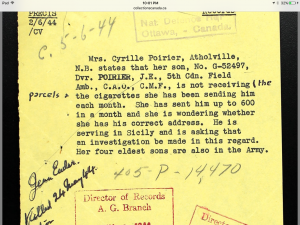
The Italian Campaign was the name of the Allied effort to gain control of Italy. This effort was mainly headed up by the Canadians, who had not yet played a major role in the war.

After taking Sicily by surprise, the Canadians started to push up through the south of Italy. While the Italians were quick to surrender, the Germans continued to fight. The Canadians slowly pushed the Germans out of city after city, however, these cities remained dangerous for Canadians even after the Germans were gone. Before the Germans were pushed out of a city, they would leave many devastating booby traps in their wake. These booby traps were disguised as everyday objects and claimed the lives of quite a few soldiers. At first these booby traps surprised Canadians, but eventually they began to expect them. So, how did the Canadians alter their tactics to deal with German booby traps?
Tactic #1: Be Paranoid
The Canadians’ first tactic to deal with booby traps was to be suspicious of literally everything. Soldiers were advised to not touch anything other than their own equipment.

Even the most commonplace objects had the potential to be booby traps. A rifle leaned up against a tree might have a bomb inside, a can of peas might be rigged with explosives, and even a lump of coal could explode in your hands. A sense of paranoia was felt throughout the Canadian force as they were warned to not touch anything. And this worked, as many booby traps were now left untouched and un-triggered. However, there was still always that one soldier who tried to kick an abandoned German helmet..(Boom!)

Tactic #2: Study Drawings of Booby Traps
Another way that the Canadians dealt with booby traps is they would commission artists to draw what booby trapped versions of everyday items would look like.


Soldiers were shown these images so that they would be more likely to know what a booby trap looked like. This tactic worked well and really did help prepare the soldiers. In fact, this tactic was not just used by the Canadians, but the whole allied force. The drawings would show the subtle differences between a normal object, and a booby trapped object.

If a soldier had seen these drawings, them they were much less likely to open a can of explosive tuna… (Again Boom!)
Tactic #3: Inspect Grenades
Canadians were also taught how to inspect some objects to see if they were booby traps. For example, Germans would sometimes leave grenades around a city. If a Canadian tried to use this grenade, it would explode in their hands. However, Canadians were taught how to inspect grenades to test their authenticity:

1. Unscrew the explosive cylinder from the wooden handle.
2. Remove the detonator and the fuze, which projects from the handle.
3. Unscrew the cap at the end of the handle and let the porcelain bead hand down.
4. Unscrew the delayed-action device in the top of the handle to make sure that the delay-action cylinder actually contains the compressed gun powder.
5. The grenades can then be put together again by carrying out the above operations in the reverse order….
These tips helped Canadians not explode from grenades that go off a little too early.
Tactic #4: Keep Your Morale High
Finally, Canadians had to try and keep a high morale. Since a booby trap would usually only injure or kill one or two people, one of their main purposes was to discourage the Allies. One minute you think you’ve won a battle, the next minute the can of peas your comrade opens explodes in his hands. This would rock you and the morale of your squadron would be devastated. And while soldiers had to be suspicious of items due to booby traps, this would make them way too suspicious. Some booby trap deaths were basically unavoidable, so the Canadians had to do the best they could to keep their morale up in spite of the occasional (or sometimes not so occasional) booby trap.
The Canadians has some pretty unique ways of dealing with German booby traps. The end result; low deaths caused by booby traps and the Germans finally being driven out of Italy.






































